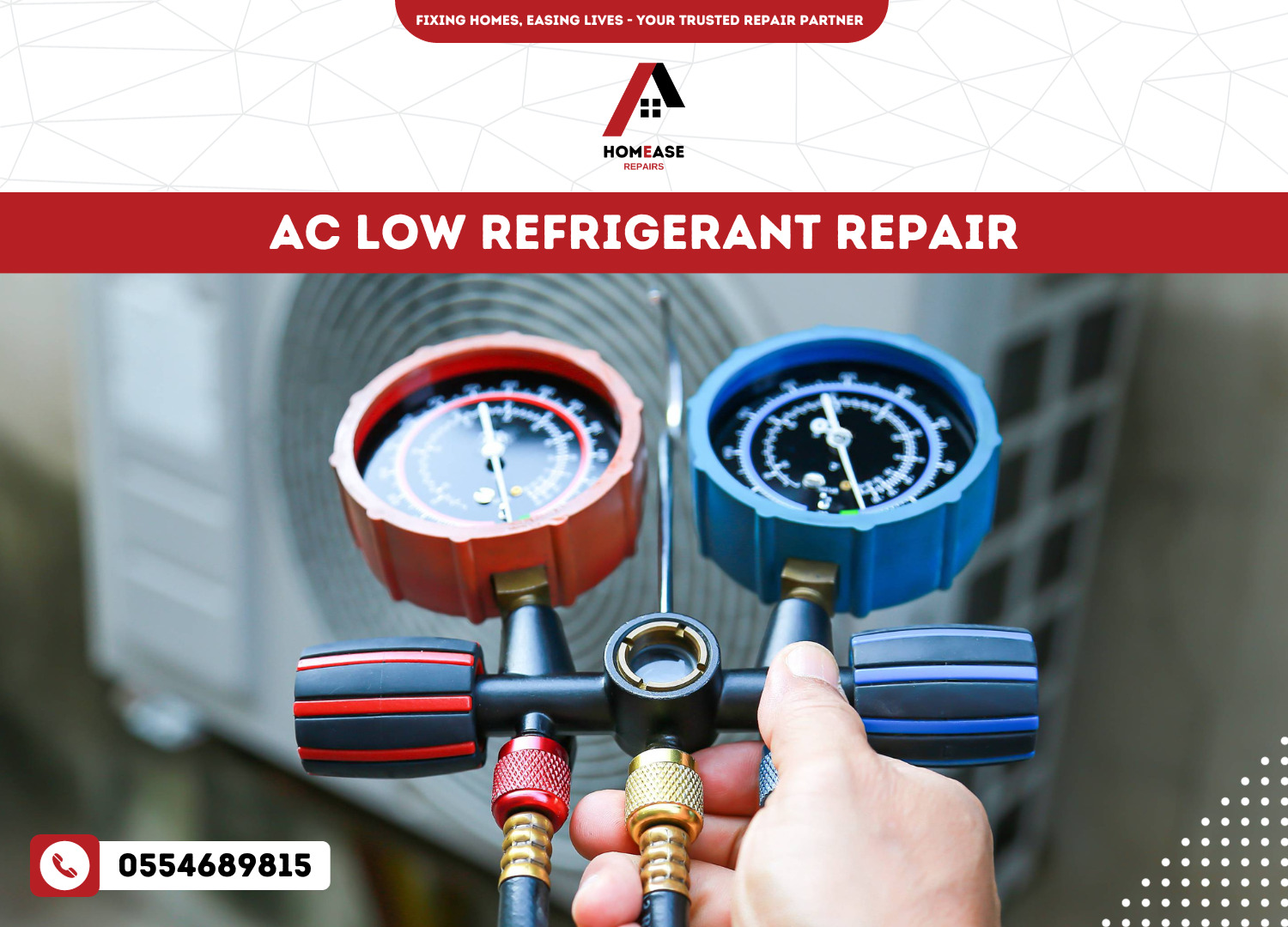A functional and efficient AC is necessary in every home and office in the heat of Dubai. But sometimes your AC needs to provide the expected cooling, and the biggest reason for this could be low refrigerant. If the refrigerant level is not up to par, the cooling system of the AC will not work correctly, no matter how high-quality it is. Home Ease Repairs offers expert AC Low Refrigerant Repair services in Dubai that will repair your AC efficiently and quickly.
We know that every AC issue has a unique solution. We solve the issue temporarily, identify the root cause, and provide a proper solution. When you AC is not cooling properly then its sign of worry that the refrigerant is low or needs repairing.
Table of Contents
ToggleLow Refrigerant Repair and Why it is Important?
Refrigerant is known as a chemical and in other words some call it gas. It generate heat inside the AC unit. If the level of refrigerant gets low then its performance get affected. And it will be appear on different components of AC unit like compressor, coil or condenser. It needs to be repaired or checked up immediately to avoid expensive repair or replacement of the complete AC.
Never delay the problem you’re facing with the refrigerant as it will become worst and maybe whole unit becomes useless. So better call Home Ease Repairs today and get the best AC Repair Dubai Services.

Low Refrigerant Repair by Home Ease Repairs?
At Home Ease Repairs, we use advanced diagnostic tools and techniques to help us understand the real cause of the problem. There is a detailed process we follow:
- Inspection: Our first step is to perform a detailed system inspection. In this, we check the refrigerant levels and identify the lux.
- Leak Detection: If the level of refrigerant is low then it must be leakage in it. We have a advance and latest tools to detect the leakage inside the unit.
- Repair: Sometime seals are the main issue for leakage, we will replace them and replace the damage area.
- Refrigerant Recharge: Recharges proper refrigerant into the system to restore cooling.
- Final Testing: Let’s test the system to ensure that it is now working efficiently and correctly.
All these steps are done by professional and certified technicians who repair your system without extra stress.
The effect of low refrigerant on your pocket
If the issue of low refrigerant is not resolved timely, it creates problems for the system and increases your electricity bills. Because of the low refrigerant, the AC has to consume more energy to provide the required cooling. Therefore, with timely AC Low Refrigerant Repair in Dubai, you restore the system’s efficiency and ensure long-term cost savings.
Emergency repair in every corner of Dubai
If your AC suddenly fails in the extreme heat of Dubai, it can become an emergency. Our Emergency AC Repair service is specially designed for situations that demand urgent solutions.
Our technicians are always available whether you call at 2 am or in the afternoon. We reach your location quickly, detect the issue and resolve it efficiently.
Best service for a new installation
If you are moving to a new home or office, or an old system seems outdated, take advantage of one of our installation services.
We ensure that the installation process is flawless and timely. Every component is set correctly, and the best configuration of ducts and vents is ensured. That not only makes cooling better but also increases energy efficiency.
A unique feature of our installation service is that we don’t just follow a standard process – we customize it according to your space to provide maximum comfort and cooling.
Signs need refrigerant repair.
A bad refrigerant problem isn’t always obvious, but there are some clear signs you may notice:
- Uneven Cooling: If it provides proper cooling in one room and not in another, there could be a refrigerant issue.
- High Energy Bills: If bills rise unexpectedly, the system may consume more energy.
- Hissing or Bubbling Sounds: These sounds could signify refrigerant luck.
- AC Not Cooling Properly: A refrigerant recharge may be needed if one starts but is not cooling.
- Frozen Coils: Low refrigerant can cause the refrigerant to freeze the coils, which further reduces cooling.
Whenever you see any of these signs in your AC system, its time to contact us immediately.
FAQs
- What does a low refrigerant repair cost?
The cost depends on the system’s condition and the repair’s complexity. But we offer you affordable and transparent pricing.
- How effective is the system after recharging the refrigerant?
After proper repair and recharge, your device becomes 100% efficient and provides optimal cooling.
- Can Low refrigerant damage the compressor?
Yes, if not repaired timely, low refrigerant puts unnecessary stress on the compressor, which may lead to its failure.
- What is the response time of emergency repair service?
We reach every area of Dubai within 30-60 minutes.
- Are refrigerant recharge options compatible?
Of course, we use eco-friendly refrigerants that are safe for the environment and your system.
Why choose home ease repairs?
You can trust us for any auto repair Dubai or emergency auto repair needs in Dubai as we offer:
- Expert and certified technicians.
- Quick and reliable services.
- Transparent and affordable pricing.
- Modern tools and eco-friendly materials.
Your comfort is our priority. Don’t let the heat fail your system – bring your system back to life with our professional services.
Call today and make your home or office cooling system flawless!
Our other group of services: